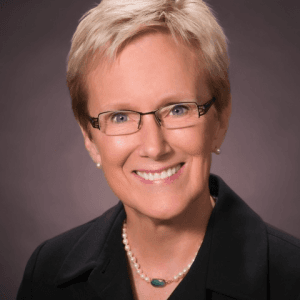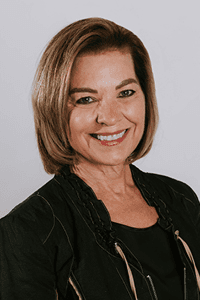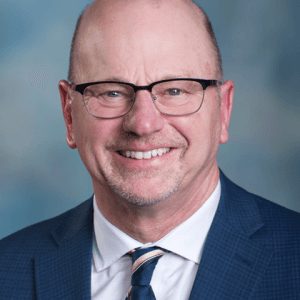This article was produced for ProPublica’s Local Reporting Network in partnership with Honolulu Civil Beat
ProPublica
Currently only one woman in a position of leadership among 11 institutions

North Dakota University System leaders are, from left to right starting at the top, NDSU President David Cook, UND President Andrew Armacost, Chancellor Mark Hagerott, NDSCS President Rod Flanigan, Williston State President Bernell Hirning, Minot State President Steve Shirley, Lake Region President Doug Darling, Mayville State President Brian Van Horn, Dakota College Bottineau Dean Carmen Simone, Dickinson State acting President Ty Orton, Bismarck State Interim President Brent Sanford and Valley City State President Alan LaFave. (Photos provided by North Dakota University System)
Former university leaders are raising concern about the lack of women in top leadership positions at North Dakota’s 11 public higher education institutions. Currently only one has a woman president or CEO.
This comes at a time when the State Board of Higher Education is beginning the process of filling president vacancies at campuses in Bismarck, Dickinson and Devils Lake. In addition, North Dakota University System Chancellor Mark Hagerott will leave his position toward the end of the year.
Those raising the profile of the issue point out that nationally and within the state, women account for between 50-60% of enrollment and graduation rates in higher education.
They believe leadership at those institutions should better reflect those figures.
“The SBHE’s record for hiring women in CEO positions for the last 25 years shows a pattern and practice of discrimination on the basis of gender,” said Ellen Chaffee, who served 15 years as president at Valley City State University (1993-2008) and nine of those concurrently as president of Mayville State University through 2001.
Chaffee notes that five institutions had female presidents during the 1990s. That dropped to zero after 2008, until Valley City had two between 2014-2018, and North Dakota State College at Bottineau hired a woman leader in 2020.
Nationally, rates of women in president or CEO positions at colleges and universities rose by 10% from 2006 to 2022 and currently women comprise around 33% of those top leadership spots across the country.

“When it comes right down to it, in my opinion, there needs to be a concerted effort to hire more diversity,” said Debora Dragseth, Baker Boy Professor of Leadership at Dickinson State University who served as vice-president there from 2020-2022.
“It’s the right thing to do,” Dragseth said. “It’s ethical. But also the fact that the majority of college students are female. Who’s representing them? Who’s walked in their shoes?”
Dragseth calculated that women have served as the top leaders at higher education institutions throughout the state just under 6% of the time over the course of their history.
Five of North Dakota’s higher education institutions have never had a formal woman leader, including the University of North Dakota, Minot State University, Dickinson State University, Williston State University, and North Dakota State University (NDSU). NDSU did have an interim woman president for a brief period in 1969.
With Bismarck State College, Dickinson State University and Lake Region State College all in the process of searching for presidents, SBHE chair Tim Mihalick said there’s an opportunity to add female leaders at one or more of those schools.
“From my perspective, and I think of the board in general, I agree, we need more female representation,” Mihalick said. “When we get the qualifications that match the institution’s needs, I would absolutely see us hiring a female leader.”
A big aspect of finding the best candidates is being intentional during the search process, said Kim Lee, director of community strategy and engagement at the American Council on Education in Washington, D.C.

ACE has been active for two decades in promoting an initiative to try to reach parity in hiring top leadership in higher ed called Moving the Needle: Advancing Women in Higher Education Leadership.
“We still have more work to do if we want to look at gender parity,” Lee said.
She said it would be beneficial for search committees to tap into leadership development programs ACE has developed, and to consider using search firms that strongly consider diversity in their processes.
The process of filling a vacancy starts with the chancellor appointing a search committee. A presidential search typically takes 4 to 6 months, according to NDUS staff, with the SBHE providing direction on the use of a search consultant.
Procedural rules require the committee to submit at least three candidates for consideration by the SBHE.
“It’s probably not out of the reach of the discussion around this to ask the search firms to look for strong female candidates,” Mihalick said.

Chaffee said that the best pools of candidates include the best men and best women and are diverse in other key dimensions as well.
“You can’t be sure you’re selecting the best if you discount or fail to attract women applicants,” Chaffee said.
She also believes the SBHE and the chancellor’s cabinet at the NDUS both need more female representation, and that this could attract more qualified female candidates to president positions. The SBHE currently has just one female voting member.
On Jan. 14, State School Superintendent Kirsten Baesler announced six finalists – five men and one woman – for two open seats for the SBHE. Those names have now been forwarded to Gov. Kelly Armstrong for his first SBHE appointments of his new governorship, with terms beginning July 1.
“College students need to see and interact with diverse people as part of preparing for success after graduation,” Chaffee said. “If the SBHE does not seek, recruit and hire women, there is virtually no chance they will have strong women applicants and have the best possible new presidents.”
Carmen Simone, campus dean and North Dakota State College at Bottineau, said that while she appreciates the sentiment regarding the need to hire more women leaders, her own experience has been “extremely positive” and she is “grateful for the support we receive as leaders.”
Of the SBHE, she said: “I have full confidence that they will carefully consider the qualifications of each candidate and ultimately, they will choose the leaders who they believe will best serve our respective institutions.”
The North Dakota News Cooperative is a non-profit news organization providing reliable and independent reporting on issues and events that impact the lives of North Dakotans. The organization increases the public’s access to quality journalism and advances news literacy across the state. For more information about NDNC or to make a charitable contribution, please visit newscoopnd.org.
External


The North Dakota News Cooperative is a new nonprofit providing real journalism about North Dakotans for North Dakotans. To support local journalism, make your charitable contribution to www.newscoopnd.org.
This article was produced for ProPublica’s Local Reporting Network in partnership with Honolulu Civil Beat
ProPublica
Inspired by her grandparents, Tonah Fishinghawk-Chavez proves that caring for the community is an action, not just a word
Police and family looking for Angel Mendez and Zayne LaFountain
The billboard project is expanding to Oregon
The film tells the story of white buffalo calves on the Turtle Mountain Reservation
Two years ago, Angela Buckley-Tocheck turned to Native Inc. for assistance with housing and to escape traffickers. Now she works there